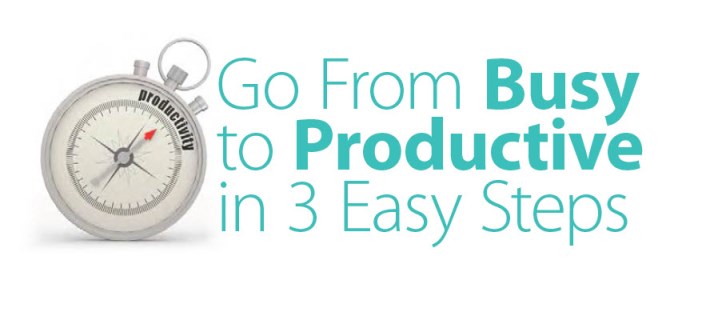Linda walks through the doors of the hotel and into the conference. Bob greets her and asks, “How’s business?”
“Busy,” she says proudly.
“Well, that’s a good problem to have,” Bob says. But, now, unknown to Linda, he’s thinking he needs to cultivate relationships with other writers. Writers who aren’t too busy to devote the time and attention it takes to do a top-notch job when he needs help.
How often do you answer, “Busy,” or something similar?
I used to do it myself.
We do it because it’s an easy answer and it shows we’re in high demand, BUT it could be backfiring on us.
It could be sending the wrong signal.
Saying business is “busy” is different from saying it’s “good.” Try saying, “I’ve been getting great results for my clients. Business is good.” You’ll trigger a very different response!
When you tell people how busy you are, they may be hesitant to give you referrals. If they’re clients, they may worry about giving you more work, thinking you won’t be able to give their job the attention it deserves.
That’s NOT a message I intend to send!
But, let’s take this even deeper…
Are you telling yourself that you’re too busy?
What Does “Busy” LOOK Like?
In my world, “busy” looks like a cluttered desk covered with piles of notes for projects, bills to be paid, records to be filed, business cards I’ve collected from various events, and so on.
I’ve always been able to find items I need on my cluttered desk. I know which of the many piles to look in. But it does take me some time to sift through those piled-up papers looking for exactly what I’m after.
But just as saying, “I’m busy,” may be sending someone else a message that I don’t mean to send, my cluttered desk was sending a “busy” message too — it was making my subconscious brain shout, “NO MORE!”
My clutter was pushing my brain into data and sensory overload… making me distracted and less productive when I sat down to write.
I was finding it harder to concentrate at my desk. I started taking my work to other places around the house, but that took me away from my notes and files… yet I had to get away from all that “busy-ness.”
So I cleared off my desk, found a space for everything, and now I’m making better use of my time and am much more productive.
If it worked for me, it can work for you, too.
So, here we go…
3 Steps to a More Productive, More Profitable Workspace
1. Clean it up by ruthlessly throwing out what you don’t need.
If you’re like me, you collect promotional pens that people give out at trade shows and conventions. We’re writers, but even the most prolific writer doesn’t need as many as I discovered tucked away in, on, and around my desk when I cleaned it up.
Confession: I had 18 just from the last wine industry trade show I attended. I kept the best ones and tossed the rest.
Speaking of trade shows and conventions, what are you doing with all the business cards you collect? When I cleaned up my desk, I counted 104 that had been taking up room. Really.
I recommend using an app to digitally store all that contact info. One popular option is Evernote for business cards, where you can save business card info with a snap of a photo. You can then use those photos to update contacts with notes and related documents, not to mention search your phone for every connection you’ve ever made. It took me about 30 minutes to remove the claustrophobic clutter of all those business cards.
Next, I gathered up the notes and loose papers and went through those. Some I tossed. I put those that I still needed to keep in one consolidated pile. Bills to pay went in their own pile.
Now is a good time to actually clean your desk, too. Mine was pretty dirty underneath all the “stuff.”
So to recap, your “clean it up” action steps are:
- Toss out (or give away) excessive office supplies.
- Scan business cards and keep contact info in a digital format.
- Go through loose papers and notes to decide which are “must keep.” Throw the rest away. Consider scanning the “must keep” notes into Evernote. They’ll be searchable by text — even if the text is handwritten — which will make them easier to use, and you’ll eliminate that clutter, too.
- Clean the dust, dirt, and grime off your desk.
2. Organize the stuff you need so it’s easy to get to and use.
Think about an airplane… Space is limited, so there’s a designated place for everything, and everything must be in its place.
Approach your desk with the same mindset.
I like organizing paper into file folders — nice, tidy compartments for ideas.
I have four retainer clients that I do work for every month. I keep hanging file folders with notes on their projects in a portable file box next to my desk. It’s handy when I want to take my laptop to the deck and work in the fresh air — I just grab the folder I need and go.
Notes on ideas for prospects — those who I’d like to work with but who are still in the “developing a relationship” stage — go into pink file folders.
Proposals that are awaiting final approval are in green.
Notes on active projects for clients are in bright orange folders.
These various file folders now reside within easy reach in a vertical file holder on the corner of my desk. It’s still the pile concept, but much more conducive to productive work.
The pens I kept (you knew I couldn’t throw away my entire collection!) are stashed in holders and in my desk drawer. Bills to pay have their own vertical file system.
It may seem simple — because it is! The trick is in actually doing it… and then to keep doing it.
Your “organize it” action steps are:
- Give everything its own designated space.
- Put things in their place.
3. Develop a strategy to keep it clean.
I confess that I’ve done this clean sweep before, and my desk never seemed to remain clean for long. I have a new strategy for that, too…
Figure out what the “rent” for each square foot of your desk is. We’ll use an example of $60,000 annual revenue, which equates to $5,000 per month. And we’ll use my desk dimensions of 2.25 ft. x 4.25 ft., which is about 9.5 sq. ft. So using these specifications, every square foot of desk space is worth $523 each month.
If it’s taking up $523 worth of space, it better be worth it!
Assigning concrete value to my workspace has been incredibly empowering. You can use my “value per square foot” strategy, or come up with one of your own. You need something that will motivate you to keep your desk the clean productive space you’ve now made it.
I know this approach is somewhat controversial, and you might be resistant to the idea of keeping a clean desk. You might be convinced that you thrive in “creative chaos.” But a clean desk is working for me, and it just might work for you, too.
You owe it to yourself, your business, and your bank account to try it for a few weeks. If you’re more productive, great! If not, you can (easily) let the clutter accumulate again. Either way, you’ll know if a clean desk helps you go from busy to productive.
But at the very least, stop telling people (and yourself) how “busy” you are! Instead, tell everyone “business is good” — and mean it.






